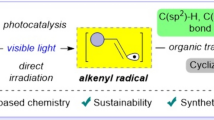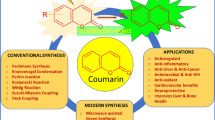Abstract
Purpose. The purpose of this work was to study the photostability of the antiproliferative tyrphostin drug compounds RG 13022(I) and RG 14620(II) as a part of preformulation program.
Methods. The compounds were exposed to cool white fluorescent light in solution as well as in the solid state and analyzed by HPLC. The degradation products were isolated chromatographically and their structures determined by spectroscopic methods. X-ray crystallographic analyses of the above compounds and their solid state degradation products were carried out to understand the mechanism of photodegradation.
Results. The compounds were found to undergo efficient photochemical transformations in solution as well as in the solid state. The degradation in the solution was due to the photoisomerization into their E-isomers (III and IV). The solid state photodegradation products were [2 + 2]-cycloaddition products (V and VI). The stereochemistry of the photocycloaddition products was indicative of the crystal packing of their monomeric precursors. The photocycloaddition product of RG 13022 possesses the head-to-tail linkage as expected from the head-to-tail packing of RG 13022 molecules in the crystal. The photocycloaddition product of RG 14620, however, was found to involve head-to-head linkage in agreement with the head-to-head crystal packing of RG 14620.
Conclusions. Drug compounds containing open chain olefmic double bonds could be sensitive to mild condition of light in the solid state if the distance between the two double bonds in the crystal approaches 4.2°A and they have suitable UV absorption characteristics. Attractive interactions between chlorine atoms have significant influence in controlling the crystal packing of chlorinated aromatic compounds.
Similar content being viewed by others
REFERENCES
A. Levitzki. Tyrphostins-Potential antiproliferative agents and novel molecular tools, Biochem. Pharmacology. 40:5:913–918 (1990).
T. Hunter and J. A. Cooper. Protein Tyrosine kinases, Annual Rev. Biochem. 54:897–930 (1985).
G. D. Plowman, A. Ullrich and L. K. Shawver. Receptor tyrosine kinases as targets for drug intervention. DN & P, 7, 6 (1994).
A. Levitzki and A. Gazit. Tyrosine kinase inhibition: An approach for the development of many drugs, Science. in press: (1994).
J. J. Elder, G. J. Fischer, P. B. Lindquist, G. L. Bennett, M. R. Pittelkow, R. Coffey, L. Ellingsworth, R. Derynck and J. J. Vourhees. Overexpression of transforming growth factor alpha in psoriatic epidermis, Science. 243:811–814 (1988).
R. M. Lyall, A. Zilberstein, A. Gazit, C. Gilson, A. Levitzki and J. Schlessinger. Tyrphostins inhibit epidermal growth factor (EGF)-receptor tyrosine kinase activity in living cells and EGF-stimulated cell proliferation, J. Biol. Chem. 264:14503–14509 (1989).
B. Margolis, S. G. Ree, S. Felder, M. Merric, R. Lyall, A. Levitzki, A. Ullrich, a. Zilberstein and J. Schlessinger. EGF induces tyrosine phosphorylation of phospholipase C-II: A potential mechanism of EGF receptor signalling, Cell. 57:1101–1107 (1989).
A. Gazit, P. Yaish, C. Gilon, and A. Levitzki. Tyrphostins I: Synthesis and biological activity of protein tyrosine kinase inhibitors, J. Med. Chem. 32:2344–2352 (1989).
R. Ross. The pathogenesis of atheroclerosis, New Eng. J. of Medicine. 314:488–500 (1986).
Molecular Structure Corp. (1965). TEXSAN, Structure Analysis package, ver. 2.0, 3200A Research Forest Drive, The Woodlands, TX 77381 (1987).
C. J. Gilmore, MITHRIL. A Computer Program for Automatic Solution of Crystal Structures, University of Glasgow, Glasgow, Scotland, 1983.
J. Luo, H. L. Ammon and G. J. Gilliland. PLOTMD, An IOn-teractive Program to modify molecular plots on a graphics terminal. J. Appl. Cryst.:22:186 (1989).
C. K. Johnson. ORTEP II, Report ORNL-5138. Oakridge National Laboratory, Oak Ridge, TN, (1976).
G. M. J. Schmidt. Pure Appl. Chem. 27:647 (1971).
G. R. Desiraju. Organic Solid State Chemistry, Elsevier, Amsterdam, 1987.
B. S. Green and G. M. J. Schmidt. Israel Chemical Society annual meeting abstracts. 190 (1971).
B. S. Green and G. M. J. Schmidt. Topochemically-controlled Solid-state Photodimerization to a Tricyclo [6.2.0.03,6] Decane derivative, TetrahedronLetters. 4249 (1970).
J. A. R. P. Sarma and G. R. Desiraju. Crystal Engineering via Cl Non bonded interactions. The Novel 2:1 Complex, 6-Chloro3′4,-(methylenedioxy)cinnamic acid. Topochemical conversion into an unsymmetrical cyclobutane and kinetics of the reaction, J. Chem. Soc., Chem. Commu. 145 (1984).
F. H. Quina and D. G. Whitten. Medium effects on photochemical reactions. Photochemistry of surfactant Alkyl-4-Stilbazole salts in solution, in the solid state, and in monolayer assemblies, J. Am. Chem. Soc. 97:1602 (1975).
Author information
Authors and Affiliations
Rights and permissions
About this article
Cite this article
Kumar, N., Windisch, V. & Ammon, H.L. Photoinstability of Some Tyrphostin Drugs: Chemical Consequences of Crystallinity. Pharm Res 12, 1708–1715 (1995). https://doi.org/10.1023/A:1016213721861
Issue Date:
DOI: https://doi.org/10.1023/A:1016213721861




